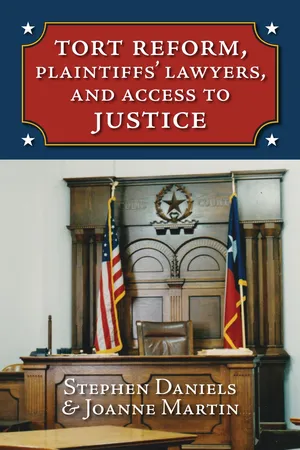
- 272 pages
- English
- ePUB (mobile friendly)
- Available on iOS & Android
Tort Reform, Plaintiffs' Lawyers, and Access to Justice
About this book
Tort reform is a favorite cause for many business leaders and right-leaning politicians, who contend that out-of-control lawsuits throttle growth and inflate costs, particularly in healthcare. Less is said about how such reforms might affect the ability of individuals to recover damages for injuries suffered through another party’s negligence. On that count, Texas—where efforts at tort reform have been energetic and successful—provides an opportunity to appraise the outcome for plaintiffs and their lawyers, an opportunity that Stephen Daniels and Joanne Martin take full advantage of in this timely and provocative work. Because much of the action on tort reform takes place on the state level, a look at the experience of Texas, a large and important state with a very active plaintiff’s bar, is especially instructive.
Plaintiffs’ lawyers work on a contingency fee basis, collecting compensation for themselves as a percentage only if they win. Reduce lawyers’ ability to use contingency fees as compensation, as tort reform inevitably does, and you reduce their economic incentive to do this work. Daniels and Martin’s study bears this out. Drawing on over 20 years of research, extensive surveys and interviews, the authors explore the impact the tort reform movement in Texas has had on the ability of plaintiffs to obtain judgments—in short on private citizens’ meaningful access to the full power of the law. In the course of their analysis, the authors explain the history and economics behind the workings of the plaintiffs’ bar. They explore how lawyers select cases and clients, as well as the referral process that moves cases among lawyers and allows for specialization. They also examine the effects of medical malpractice reforms on plaintiffs’ lawyers—reforms that often close the courthouse doors to certain types of people—tort reform’s “hidden victims.”
Plaintiffs’ lawyers are the civil justice system’s gatekeepers, providing meaningful access to the rights the law provides. Daniels and Martin’s thorough and fair-minded work offers a unique and sobering perspective on how tort reform can curtail this access—and thus, the legal rights of American citizens.
Frequently asked questions
- Essential is ideal for learners and professionals who enjoy exploring a wide range of subjects. Access the Essential Library with 800,000+ trusted titles and best-sellers across business, personal growth, and the humanities. Includes unlimited reading time and Standard Read Aloud voice.
- Complete: Perfect for advanced learners and researchers needing full, unrestricted access. Unlock 1.4M+ books across hundreds of subjects, including academic and specialized titles. The Complete Plan also includes advanced features like Premium Read Aloud and Research Assistant.
Please note we cannot support devices running on iOS 13 and Android 7 or earlier. Learn more about using the app.
Information
Table of contents
- Front Cover
- Title Page
- Copyright Page
- Dedication Page
- Contents
- List of Figures and Tables
- Preface
- Acknowledgments
- 1. In the Crosshairs
- 2. “They Grabbed the Pendulum . . . and Nailed It to the Wall!”: Highlights of Tort Reform, Texas Style
- 3. A Glimpse of the Past and the Development of the Texas Plaintiffs’ Bar
- 4. The Tension between Professional Norms and the Need to Generate Business: A Window into Professional Identity
- 5. “People Like Me Are Really the Majority of Plaintiffs’ Lawyers”: Structure and Hierarchy in the Texas Plaintiffs’ Bar
- 6. “If My Referring Lawyers Go Away, I’m in Trouble”: Reputation, Specialization, and the Referral of Cases
- 7. “The Juice Simply Isn’t Worth the Squeeze in Those Cases Anymore”: Damage Caps, “Hidden Victims,” and the Declining Interest in Medical Malpractice Cases
- 8. Conclusion: “Unless There’s a Way to Make Money Practicing Law, Rights Don’t Make Any Difference”
- Methodological Appendix: Interviews and Surveys
- Index
- Back Cover